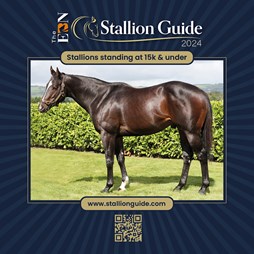John Boyce grew up on a stud farm and is a bloodstock journalist and former editor of Pacemaker and of The Thoroughbred Breeder. He was part of the Darley/Godolphin team from 2001 to 2022 as Group Marketing Head and then Group Head of Research. He is currently a partner in a data analytics company based in London.
Early winners versus Stakes success
John Boyce analyses how successful first crop sires have fared in their subsequent careers
Get in. Make your money. Get out. That used to be the modus operandi of most of the smaller commercial stud farms. Stallion masters who could not afford to ignore the profit imperative always aimed to have a stallion bought and paid for by the time his first two-year-olds reached the racecourse. By that juncture, the stallion would have served three books of mares, enabling the stallion master to recoup its purchase price.
Nowadays, finding a suitable stallion and paying for it is tough, so much so it has led to risk-sharing with breeders through syndication and the sale of breeding rights. But either way, the stallion studs are always forced to contemplate a short career for their charge, particularly at the lower end of the market where good mares – that oh-so-scarce commodity required to make a stallion – are in very short supply.
And, as commercial breeders continue more and more to shape the rules of the game, there is an even greater emphasis on the fast, commercial first-season sire at the expense of many others that are in fact better racehorses with better pedigrees and therefore perhaps better for the long term health and variety of our racing.
The past three seasons have seen record numbers of new stallions retiring to stud in Britain and Ireland. An over-supply of new and unproven sires may suit the nomination buyer but it can be counterproductive for the stallion as he’ll attract fewer mares and fewer good mares.
It’s clear that the ability to sire plenty of winning youngsters from a first crop is no guide to future success.
Little wonder then that our list of the best first-crop sires since 2000 ranked by individual winners is dominated by sires with just one year in the limelight. True, part of the reason why they are there in the first place is because we bestow too much attention on this group but, given that they’ve already gained a competitive advantage over their peers from the good mares they get in year one, would it not be better all round to assess their merit by looking at the general two-year-old tables?
| SIRES RANKED BY FIRST-CROP 2YO WINNERS IN EUROPE 2000-2016 | |||||
| Stallion | To Stud | FC Rnrs | FC Wnrs | Career BTW | % |
| Iffraaj | 2007 | 71 | 37 | 36 | 5.8 |
| Invincible Spirit | 2003 | 69 | 35 | 97 | 8.3 |
| Dubawi | 2006 | 70 | 34 | 122 | 15.5 |
| Canford Cliffs | 2012 | 75 | 34 | 6 | 2.7 |
| Dutch Art | 2008 | 58 | 33 | 28 | 5.6 |
| Red Clubs | 2008 | 76 | 33 | 7 | 3.8 |
| Zoffany | 2012 | 83 | 32 | 12 | 4.8 |
| Captain Rio | 2004 | 91 | 32 | 13 | 2.3 |
| Sir Prancealot | 2013 | 77 | 32 | 2 | 1.6 |
| Zebedee | 2011 | 85 | 32 | 4 | 1.2 |
| Dark Angel | 2008 | 71 | 31 | 44 | 7.2 |
| Fasliyev | 2000 | 73 | 31 | 25 | 2.3 |
| Choisir | 2004 | 71 | 30 | 30 | 6.0 |
| Orpen | 2000 | 71 | 30 | 37 | 4.4 |
| Kheleyf | 2005 | 68 | 30 | 20 | 2.6 |
| Mastercraftsman | 2010 | 74 | 29 | 32 | 6.7 |
| Showcasing | 2011 | 55 | 29 | 11 | 4.8 |
| Acclamation | 2004 | 60 | 28 | 46 | 4.9 |
| Fast Company | 2011 | 68 | 28 | 9 | 3.5 |
| Approve | 2011 | 60 | 28 | 5 | 2.5 |
| Bertolini | 2002 | 79 | 28 | 12 | 1.6 |
| Cape Cross | 2000 | 54 | 27 | 94 | 7.4 |
| Excellent Art | 2008 | 68 | 27 | 19 | 3.9 |
| Hawk Wing | 2004 | 79 | 27 | 15 | 2.3 |
| Noverre | 2003 | 57 | 26 | 23 | 4.1 |
| One Cool Cat | 2005 | 79 | 26 | 15 | 2.6 |
| Paco Boy | 2011 | 58 | 25 | 8 | 3.4 |
| Tobougg | 2003 | 69 | 25 | 10 | 2.1 |
| Lope de Vega | 2011 | 53 | 24 | 27 | 10.2 |
| King's Best | 2001 | 57 | 24 | 57 | 5.1 |
| Sakhee's Secret | 2009 | 64 | 24 | 4 | 1.5 |
| Exceed and Excel | 2005 | 67 | 23 | 61 | 7.0 |
| Holy Roman Emperor | 2007 | 63 | 23 | 50 | 6.4 |
| Footstepsinthesand | 2006 | 74 | 23 | 41 | 5.8 |
| Ali-Royal | 1998 | 51 | 23 | 5 | 3.2 |
| Daggers Drawn | 2000 | 53 | 23 | 11 | 2.5 |
| Mull of Kintyre | 2002 | 69 | 23 | 14 | 2.3 |
| Statue of Liberty | 2004 | 64 | 23 | 6 | 1.3 |
| Lilbourne Lad | 2012 | 71 | 23 | 1 | 0.6 |
| Oasis Dream | 2004 | 61 | 22 | 109 | 10.9 |
| Shamardal | 2006 | 62 | 22 | 88 | 10.6 |
| Danehill Dancer | 1998 | 62 | 22 | 124 | 9.6 |
| Kyllachy | 2003 | 61 | 22 | 32 | 3.7 |
| Titus Livius | 1999 | 50 | 22 | 9 | 2.5 |
| Dragon Pulse | 2013 | 48 | 22 | 2 | 2.1 |
| Amadeus Wolf | 2008 | 64 | 22 | 5 | 1.8 |
| Lujain | 2001 | 59 | 22 | 4 | 1.6 |
| Antonius Pius | 2006 | 71 | 22 | 3 | 1.1 |
| Royal Applause | 1998 | 48 | 21 | 50 | 4.2 |
| Excelebration | 2013 | 61 | 21 | 3 | 2.1 |
| Frozen Power | 2012 | 69 | 21 | 1 | 0.7 |
| Montjeu | 2001 | 52 | 20 | 99 | 10.9 |
| Mozart | 2002 | 63 | 20 | 8 | 9.4 |
| Rock of Gibraltar | 2003 | 60 | 20 | 75 | 6.5 |
| Sepoy | 2013 | 51 | 20 | 6 | 4.8 |
| Foxwedge | 2013 | 51 | 20 | 2 | 2.0 |
It’s clear that the ability to sire plenty of winning youngsters from a first crop is no guide to future success. In our table of 56 stallions who sired 20 or more first-crop juvenile winners since 2000, only five can claim to have made it to the very pinnacle of success as a stallion, although others are – or were – indeed successful commercial sires standing for good fees over a number of years.
Dubawi sired 34 winning two-year-olds in his first crop but has gone on to sire 122 Stakes winners at a world-class rate of 15.5%. Lope the Vega, his sire Shamardal, Oasis Dream and Montjeu are the only other sires with at least 10% Stakes winners to runners. Those in the 10% club that failed to get past the 20-winner mark with their first crop two-year-olds feature some outstanding names: Galileo (16.5% Stakes winners; 13 first-crop juvenile winners), Frankel (15.6% Stakes winners; 19 first-crop juvenile winners), Sea The Stars (14.1%, 12 first-crop juvenile winners), Dansili (12.2% Stakes winners; 18 first-crop juvenile winners) and Pivotal (11.3% Stakes winners; 13 first-crop juvenile winners) to name a few.
Several more have been hugely successful – the types to improve their Stakes winner ratios in years to come. The ever-popular Iffraaj, who holds the current European record of for first-crop winning youngsters at 37, is set fair due to the success of, among others, Ribchester last year, plus wealthy crops in the pipeline. The Irish National Stud’s Invincible Spirit has been Europe’s finest source of speed and precocity since his first two-year-olds took the stage back in 2006. Dark Angel is another of note. Many might have expected this son of Acclamation to belong to the shooting stars, given that he was only raced at two. But he’s endured and proved to be the heir apparent to stallions like Oasis Dream and Invincible Spirit among the speed sires. Siring not one, but two world-class sprinters in the same crop – Battaash rated 136 by Timeform and Harry Angel rated 132 – underlined his immense value to breeders. Moreover, there is every chance that he’ll get a top-class miler in the years to come.
Clearly, many great sires do well with their first juveniles, but it’s hard to ignore the fact that 30 of the 56 stallions in our table sire less than 4% Stakes winners to runners and 24 less that 3%. You can be assured that many a proven sire with far better ratios will have been spurned in favour of one of these untimately failed stallions. And all in pursuit of no risk commercial appeal.
New advertised stallions to stud in 2024
Click on any of the new stallions below to go straight to their records
- ACE IMPACT
- ASYMMETRIC
- BOLSHOI BALLET
- BOUTTEMONT
- CHALDEAN
- DRAGON SYMBOL
- DUBAI MILE
- EL CABALLO
- EREVANN
- GOOD GUESS
- HURRICANE LANE
- KENWAY
- LITTLE BIG BEAR
- LUSAIL
- MAC SWINEY
- MARIE’S DIAMOND
- MIDNIGHT SANDS
- MODERN GAMES
- MOJO STAR
- MOSTAHDAF
- MUTASAABEQ
- NATIVE TRAIL
- PADDINGTON
- PYLEDRIVER
- SHAQUILLE
- SUBJECTIVIST
- THE ANTARCTIC
- TRIPLE TIME
- VADENI

Click below to buy the 2024 book.
Why Advertise Your Stallion
Each Advertised Stallion comprises:
An Overview • Stud Record • Sales Record • Race Record • Pedigree Record
